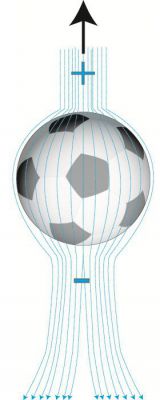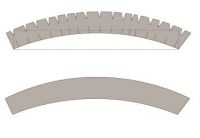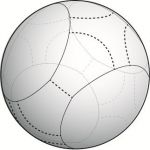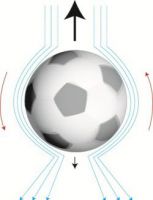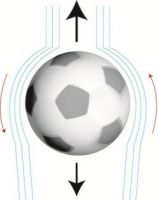The 2010 World Cup brought on the advent of the controversial Jabulani soccer ball and many questions of whether or not the ball played a critical role in some of the soccer players’ blunders during game play. Adidas engineers designed a brand new soccer ball to debut as the official World Cup ball. Jabulani featured a seamless multi-panel design aimed at providing players with a perfectly smooth and aerodynamically consistent ball. However, the ball drew heavy criticism from players and coaches who protested that the ball greatly affected the outcome of several key games. To understand some of the nuances behind the ball’s design, the logistics and forces of a soccer ball in flight must be examined to see how Jabulani differs from the traditional ball.
““Soccer is not a matter of life or death. It is more important than that.”Bill Shankly
Bill Shankly, former manager of the Liverpool Football Club and author of the above quote, exemplifies the passion and downright lifestyle that many soccer enthusiasts have around the globe [1].
The World Cup is Earth’s largest sporting event, with FIFA having stated that cumulatively some 26 billion people watched the 2010 series. The series, however, was fraught with officiating oversights, phantom injuries, questionable ejections, and endless complaints about the official match ball, the Adidas Jabulani, an anglicized version of the Zulu word “celebrate” [2]. Despite its supposed inherent flaws, there is extensive design and engineering behind creating a match-worthy soccer ball, even if its game day performances leave one with little to celebrate.
A video from Loughborough University’s website shows Frank Lampard, a player from the English Chelsea Football Club, saying that the Jabulani is a “…very strong ball, feels very good, very true to hit…” His fellow Czech teammate and goalkeeper will say of the same ball, “It’s nice to catch, because it feels good on the hands…” [2].
Ask Landon Donovan, a player from the US national soccer team, what he thinks, and he’ll tell you that it’s hard to judge the flight of long balls and difficult to hit properly in general. “You’re seeing a lot of missed chances, a lot of crosses that are mistimed or misplayed that would normally be goals, that are not going in” [3].
The Deccan Herald has Diego Maradona, Argentina’s head coach, challenging prominent soccer players and saying, “I’ve tried it myself. This ball doesn’t go round the corner, and you can’t get in a good cross to the far post because the ball flies straight. We are not going to see any good moves in this World Cup because no one can get the ball and control it” [4]. Others prefer a more abbreviated means of publicizing their grievances. David James, a goalkeeper for England’s Bristol City, declares “The ball is dreadful. It’s horrible…” [5].
Adidas was stunned and vehemently denied any design defects, with its spokesman Thomas Van Schaik stating that the ball had been in use since December of the previous year, and had only received positive feedback in the six months leading up to the 2010 FIFA World Cup [6].
So who should we believe? Are the players simply blaming equipment for poor performance, or was there a real design flaw in the extensively engineered Jabulani soccer ball?
Soccer Ball Aerodynamics
Simply put, a soccer ball should do what a player wants it to do. A defender should be easily able to give a straight, long, and precise pass to a player downfield; a striker should be able to curve a ball around a wall of players, and a goalkeeper should be able to somewhat accurately predict the trajectory of a ball while it races towards them. The ball should roll and bounce consistently (as a spherical object should) as well as display uniform flight characteristics (e.g., have consistent airflow around the ball), and English engineers at Loughborough University strived to do just that with the Jabulani soccer ball [2].
The engineers took into account some basic properties of aerodynamics. There are a few main elements in determining the trajectory of a ball in flight, namely the amount of force applied to the ball before flight, shape and surface of the soccer ball, spin (if any), drag pressure, gravity and air pressure [7]. The Jabulani soccer ball was designed to help mitigate certain forces while intensifying others.
After a soccer ball is initially kicked, gravity immediately begins to pull it downwards, giving the trajectory a hyperbolic shape. Two types of drag forces also come into play. Skin friction drag is caused by the actual contact of the air particles against the surface of the ball [8]. There is no difference between this type of friction from any other two bodies making contact.
Pressure drag refers to the air flowing over the ball (Fig. 1). The separation of air towards the rear of the ball creates a turbulence which results in high and low pressure that leaves a wake. This leaves a net negative pressure behind the ball, ultimately slowing it down [9]. This type of drag is dependent upon an object’s form. The spherical shape of the ball makes pressure drag the predominant opposing element between the two.
To reduce the surface friction drag on the ball, the Jabulani uses three dimensional molded panels instead of traditional flat panels that are fit to a round surface [2]. When a panel is bent to fit a round surface, the top half experiences tension and the lower half compression. This creates small deformations on either side, which further distort the surface (Fig. 2).
While the deformations are only seen on an incredibly small scale, they can still affect the airflow around the object. Since the Jabulani uses three dimensional panels, no bending is required, preventing further deformation of the surface, and thus reducing skin friction drag [2].
Stitching can further disrupt the smooth air flow from the front of the ball to the rear of the ball and aggravate the turbulence experienced on the surface of the ball. To reduce the unpredictability that stitches can introduce in a ball’s trajectory, the Jabulani uses only eight panels (as opposed to the traditional soccer ball’s 32) which are then thermally bonded, ensuring that no stitching is used to bind the surface. Fewer panels also means a smoother surface (Fig. 3).
An incredible round ball, however, has its drawbacks. Simon Choppin, a sports engineering researcher at Sheffield Hallam University, explains that a typical soccer ball has a dense, uniform seam pattern which yields a relatively rough surface [10]. This type of ball does not bounce or roll as consistently as a smoother one, but the airflow around it becomes turbulent almost all at once, resulting in less differentials in air pressure, leading to a smoother, more hyperbolic trajectory.
Due to the Jabulani’s incredibly smooth surface, the air becomes turbulent in one part of the ball faster than another, creating significant differences in air pressure and an unpredictable flight path. The ball, however, has a much better touch to it and rolls more consistently. To offset this problem, explains Simon Choppin, engineers used aerogrooves throughout the surface of the ball [10]. Aerogrooves are simply shallow indentations that help create a more symmetrical airflow around the ball (Fig. 4).
Depending on the seams, a typical soccer ball can experience turbulence and somewhat unpredictable trajectories between 20-30 MPH (Fig. 5). The ball’s airflow is initially laminar, so the air separates from the surface of the ball relatively quickly, creating a large negative force (Fig. 6). The ball slows down much faster. After reaching this threshold, however, the ball’s airflow becomes turbulent, and the airflow sticks to it longer, creating less drag, and greatly decreasing the rate at which the ball slows down.
This is why certain free kicks in soccer will unexpectedly dip or sway after being in the air for a few moments—the ball is initially hit from around 70 MPH, and, as it slows down, the velocity eventually falls below the critical 20-30 MPH zone, leaving the turbulence threshold and entering the laminar threshold. The ball suddenly slows down a lot more rapidly, enough to affect the trajectory [7]. A video of this very principle can be seen in a famous David Beckham free kick during a 2001 World Cup Qualifier match against Greece on the YouTube website [11]. All spheres experience this, and the Jabulani was no exception.
Adding spin to the ball adds another set of dynamics. As a spinning ball moves forward, the spinning of the ball will coincide with the direction of the air flow on one side and opposite the opposite side. Where the two complement each other, there is less pressure, and where the two oppose each other, greater pressure. The ball will naturally start moving towards where there is less pressure, hence the curve seen in kicks hit with the side of the foot which add a necessary eight to ten rotations per second for effective curvature in the trajectory [7]. This tendency to move towards the direction of the spin is also called the Magnus Effect.
The slower a ball travels with the same amount of spin, the more it will curve. This, coupled with a unique characteristic of the Jabulani, is what made the ball so unorthodox in terms of flight characteristics.
NASA and the Jabulani
NASA experts later determined what the issue was. The fact that the Jabulani is so smooth, coupled with little spin mid-flight, creates a turbulence threshold between 45- 50 MPH, which is incredibly high compared to the normal 20-30 MPH. This velocity threshold is consistent with the critical moments in which a goalkeeper must predict where a ball will go [12]. If a player wants to make a quick, straight pass over someone or take a shot towards the goal, the ball would have to have little spin, be in the air, and would thus enter this threshold. This, states Discovery Networks, combined with the fact that smooth spheres (the aerogrooves did not add enough roughness to the ball) have an asymmetrical flow around the ball caused by little spin (which are caused by unpredictable air pressures around it), leads to volatile flight paths [13]. This behavior is also known as “knuckleballing.” Discovery Networks has a video of many a goalkeeper falling victim to the Jabulani’s knuckleballing [13].
Choppin continues to explain that the Jabulani’s extreme roundness also creates higher drag force in low speeds (passes) which causes the ball to slow down or dip much faster than a typical ball [10]. At higher speeds (long passes and shots at the goal), a much lower drag force slows the ball down much more slowly than expected and makes the ball travel faster than a player would expect. Once it falls below the critical 45-50 MPH threshold, the drag increases dramatically, causing drastic changes in the flight path [10]. While all soccer balls experience this sudden change from turbulent to laminar air flow change, years of practice had made the players’ response to the ball’s trajectory intuitive. The players were simply not used to the new flight characteristics of the Jabulani.
About halfway through the tournament, FIFA finally admitted there was a problem with the Jabulani but would not act on the problem until after the World Cup was over [14].
Conclusion
While all balls experience inconsistencies in their flight path, theoretically making all balls problematic, the Jabulani soccer ball experiences unique inconsistencies, in that its major weakness is exposed during critical moments of a match (e.g., it knuckleballs immediately during a shot on the goal, making a goalkeeper’s job incredibly more difficult, etc). Experienced players are able to adapt to the irregularities of more traditional soccer balls, but the Jabulani’s primary issue was one players have never before been exposed to.
The Jabulani soccer ball, in summary, was simply too different for players to adapt to.
